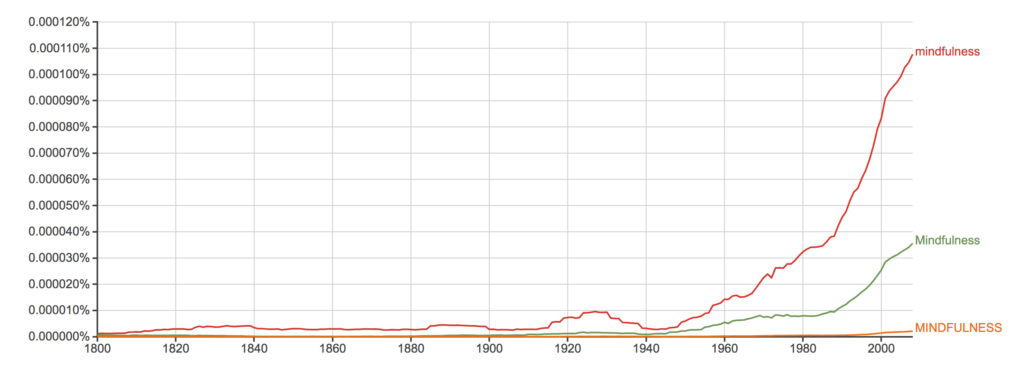Lost in thought, overwhelmed with anxiety? Pull yourself out of the trenches with Mindfulness practices!
What Really is Mindfulness?
Everywhere you look you see the word “mindfulness”. So much so, that even if you don’t know what mindfulness is, you probably don’t care! If you’re mad you’re told “just breathe, do your mindfulness.” If anything, that probably makes you more angry!

What is the Mindfulness trend?
Mindfulness has blown up in our society recently.

Mindfulness seems like it can be applied to everything in life.
Mindfulness as a couple
Mindfulness for pain, stress, substance abuse
Mindfulness to unlock the soul
Mindfulness to be a better person
Mindfulness in the workplace
Mindful parenting
you get it.
Just running a quick google shopping search on “Mindfulness” and you’ll see hundreds of books and suggestions, including “Mindfulness for Dummies”!
With all large trends, I am skeptical. (Call me a hipster?) But this really works!
Throughout grad school training the word “Mindfulness” came up in every class. So what is it?
Let’s break it down.
- Body
- Breath
- Thoughts
Mindfulness takes the stance that once you become preoccupied with thought, you become disconnected from the body, therefore making you feel more anxious.
How is it used properly?
In a therapy session, you’re almost always guaranteed to learn about Mindfulness. Why? Because it works and we (mental health professionals) believe in the research!
Mindfulness in Therapy
In therapy, mindfulness usually starts with grounding yourself in your current environment, such as a chair. You’ll be asked to notice how it feels to be where you are now, to sit in a chair and be supported, and you’ll focus a lot on breathing.
Your therapist will talk you through a meditation that involves slowing the breath, and noticing things about breathing that you’d normally take for granted.
Like, notice the cool air going through your nose to the back of your throat. Notice how it’s warmer when you exhale, notice your breathing getting slower, that type of thing.
This is so you can get used to learning how to control breath, which decreases anxiety already.
After the breathing is established, you’ll notice those pesky thoughts creeping into your mind. Don’t get frustrated! In mindfulness, this is expected and necessary. When the thoughts pop into your head or boredom starts to creep in, just simply notice it. I like to picture thoughts on a cloud, passing by you without changing you. Or maybe you’re standing by a river and watching the thoughts flow by you, but notice that you’re fine and unchanged by those thoughts. Then, move back to focusing on how it feels to breathe.
And practice! Mindfulness is not meant to be used just when you’re in a stressful situation. Mindfulness should be practiced often. Just take a few minutes each day to practice this.
Don’t have time to sit still, breathe, and get into a meditative state?
Keep reading to learn how you can easily incorporate Mindfulness exercises into your daily routine!
Benefits of Mindfulness
There are many benefits to Mindfulness, which is why it’s being promoted so much.
Mindfulness.org says, “When we’re mindful, we reduce stress, enhance performance, gain insight and aware ness through observing our own mind, and increase our attention to others’ well-being.”
Mindfulness improves happiness, sense of well-being and mood, work, and relationships.[bctt tweet=”Mindfulness reduces anxiety, stress, and disconnection from body. #selfcare” username=”therapysource”]
Practicing Mindfulness in your Daily Routine
Mindfulness is meant to be a grounding approach. This means, it’s meant to take you out of thought and into your current moment.
In therapy, breathing is usually what you’ll use for grounding. In your every day life, breathing may not be as convenient or your choice of grounding method.
But guess what? Breathing doesn’t have to be the only way you ground yourself.
Grounding can be whatever you want! It can be done sitting, walking, laying down, standing, etc. This could be practiced as simply as becoming aware that you’re becoming lost in thought, and stopping to notice things you don’t normally take the time to notice. When you start to get lost in thought, simply accept that you have wandered, and move your attention back to your grounding object (if not your breathing).
Take time to smell the flowers!
Examples of Daily Mindfulness Practices
The threading of the fabric in your chair or around you.

The way it feels to sit and be supported by a chair.

The way the water looks and sounds in the shower going down the drain.

Of course, if you don’t want to come up with your own Mindfulness exercises, you can purchase a book that’ll show you how to do it.
My point is, Mindfulness is not meant to be a “just breathe when you’re upset and don’t think about it” approach. Mindfulness is meant to practice sitting with thoughts, not trying to get rid of them, but just accepting them for being there, and then choosing to let the thought pass.
Sounds silly right?
Think about this metaphor. A radio is playing in the background (radios still exist, right?). Have you ever noticed that once you are aware of the radio playing it seems to sound louder? And if you try to stop listening to it, it gets even louder.
Mindfulness is meant to be part of your daily routine and act as a check-in mechanism for if you find yourself lost in thought.
It takes practice! Good luck in your practice.
If you like what you read or learned something new, please leave a comment below and share!




Love the article I too started to become aware of my breathing and the background sounds. Well done.
Thank you, Rose!
Pingback: Self-Care for Therapists and Mental Health Professionals
Pingback: Play Therapy with Adults
Pingback: Self-Care for Therapists and Mental Health Professionals – The Play Therapist
Pingback: Using Seashells in Play Therapy | The Play Therapist